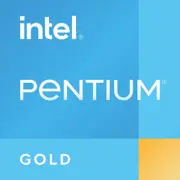Intel Pentium Gold 6500Y

Intel Pentium Gold 6500Y: A Compact Processor for Mobility and Basic Tasks
Analysis of Capabilities, Use Cases, and Comparison with Competitors (April 2025)
Architecture and Process Technology: A Legacy of the 14 nm Era
The Intel Pentium Gold 6500Y processor, released under the codename Amber Lake Y, is based on the outdated 14-nanometer architecture. This dual-core chip supports Hyper-Threading (4 threads), allowing it to efficiently handle light multitasking scenarios. The base clock speed is 1.1 GHz, and in Turbo Boost mode, it can reach up to 3.4 GHz for a single core.
The integrated graphics Intel UHD Graphics 615 is a key component for multimedia tasks. It supports 4K video (via HDMI 2.0 or DisplayPort), hardware decoding for HEVC and VP9, but is limited for gaming. The GPU architecture is based on Gen9.5 with 24 execution units (EUs), which is weaker than modern Iris Xe or Radeon Vega graphics.
Architecture Features:
- Optimized for low power consumption (TDP 5 W).
- No support for PCIe 4.0 — only PCIe 3.0.
- Maximum memory capacity — 16 GB LPDDR3-1866.
Power Consumption and TDP: Balancing Efficiency and Performance
With a TDP of 5 W, the Pentium Gold 6500Y is ideal for passively cooled devices: ultrabooks, tablets, and compact laptops. Unlike 15 W processors (e.g., Core i3-1115G4), there is no active fan here, which reduces noise but limits the duration of Turbo Boost.
Power-Saving Modes:
- Speed Shift technology for rapid frequency switching.
- Dynamic Tuning — real-time load adaptation.
- Support for C6/C8 states to minimize power consumption during idle time.
Performance: What Can You Do with the Pentium Gold 6500Y?
Geekbench 6 results (932 points single-threaded and 1535 multi-threaded) place this processor at the level of budget models from 2022–2023.
Office Work
- Microsoft Office, Google Workspace: Runs smoothly. Simultaneous work with 10-15 tabs in a browser + Word document.
- Video Conferencing: Zoom/Teams at 720p — stable, but possible stutter at 1080p.
Multimedia
- Video: Watching 4K@60 FPS (YouTube, local files) thanks to iGPU decoding.
- Editing: Only basic — trimming video in Shotcut, working with photos in Lightroom (no more than 20 MP).
Gaming
- CS:GO: 720p, low settings — 25–35 FPS.
- Minecraft (without shaders): 40–50 FPS.
- Indie games (Hollow Knight, Stardew Valley): Comfortable.
Turbo Boost: In single-threaded tasks, the frequency rises to 3.4 GHz, but under prolonged load (like PDF rendering), the processor throttles due to passive cooling.
Use Cases: Who is this CPU Suitable For?
1. Students — for studying, working with texts, and online courses.
2. Office Workers — email, spreadsheets, presentations.
3. Portable Device Users — lightweight laptops weighing up to 1 kg (e.g., ASUS ZenBook Flip).
4. Digital Nomads — long battery life (up to 12 hours on devices with a 50 Wh battery).
Not Suitable For:
- Video editing in DaVinci Resolve.
- Running modern AAA games.
- Working with virtualization (e.g., Docker).
Autonomy: How Does the Processor Affect Battery Life?
With a TDP of 5 W, laptops with the Pentium Gold 6500Y demonstrate outstanding battery life:
- Dell Inspiron 14 2-in-1 (2025): 48 Wh battery ⇒ up to 14 hours of web surfing.
- Lenovo IdeaPad Flex 5: 52 Wh ⇒ 11–12 hours under mixed load.
Power-Saving Technologies:
- Panel Self Refresh — reducing GPU load when displaying static images.
- Connected Standby — background data synchronization during sleep mode.
Comparison with Competitors: Against AMD, Apple, and Previous Generations
1. AMD Athlon Silver 7120U (Zen 2, 6 nm):
- Pros: 2 cores/2 threads, but higher IPC (+15% in single-threaded tasks).
- Cons: TDP 15 W ⇒ less autonomy. Price of laptops: from $450.
2. Apple M1 (2020):
- Pros: 8 cores, 18-hour battery life.
- Cons: macOS ecosystem, device prices start at $800.
3. Intel Core i3-10110Y (2019):
- Outdated architecture, but similar specs. The Pentium Gold 6500Y is 12% faster in multi-threading.
Pros and Cons of the Pentium Gold 6500Y
Strengths:
- Low power consumption.
- Sufficient performance for everyday tasks.
- Low laptop prices (from $400).
Weaknesses:
- Only 2 cores — multitasking is limited.
- 14 nm process technology ⇒ heating under Turbo Boost.
- Weak iGPU for modern gaming.
Recommendations for Choosing a Laptop
1. Device Type: Ultrabook or convertible (e.g., HP Pavilion x360).
2. RAM: Minimum 8 GB (better 16 GB for Windows 11).
3. Storage: 256 GB NVMe SSD.
4. Display: IPS panel with a resolution of 1920×1080.
5. Ports: USB-C with Power Delivery support for fast charging.
Model Examples from 2025:
- Acer Swift 1: $429, 8 GB RAM, 256 GB SSD.
- ASUS VivoBook S14: $499, 16 GB RAM, touchscreen.
Final Verdict: Who is the Processor Suitable For?
The Pentium Gold 6500Y is a choice for those who value mobility and battery life over raw performance. It is an ideal chip for:
- Users who need a lightweight laptop for work on the go.
- Budget devices priced up to $500.
- Scenarios without demanding graphics (e.g., connecting to an external monitor for office tasks).
Key Benefits:
- 10+ hours of battery life without plugging in.
- Silent operation and compactness.
- Affordable price.
If your needs do not extend beyond basic tasks, the Pentium Gold 6500Y remains a practical option even in 2025.
Basic
CPU Specifications
Memory Specifications
GPU Specifications
Miscellaneous
Benchmarks
Compared to Other CPU
Share in social media
Or Link To Us
<a href="https://cputronic.com/cpu/intel-pentium-gold-6500y" target="_blank">Intel Pentium Gold 6500Y</a>